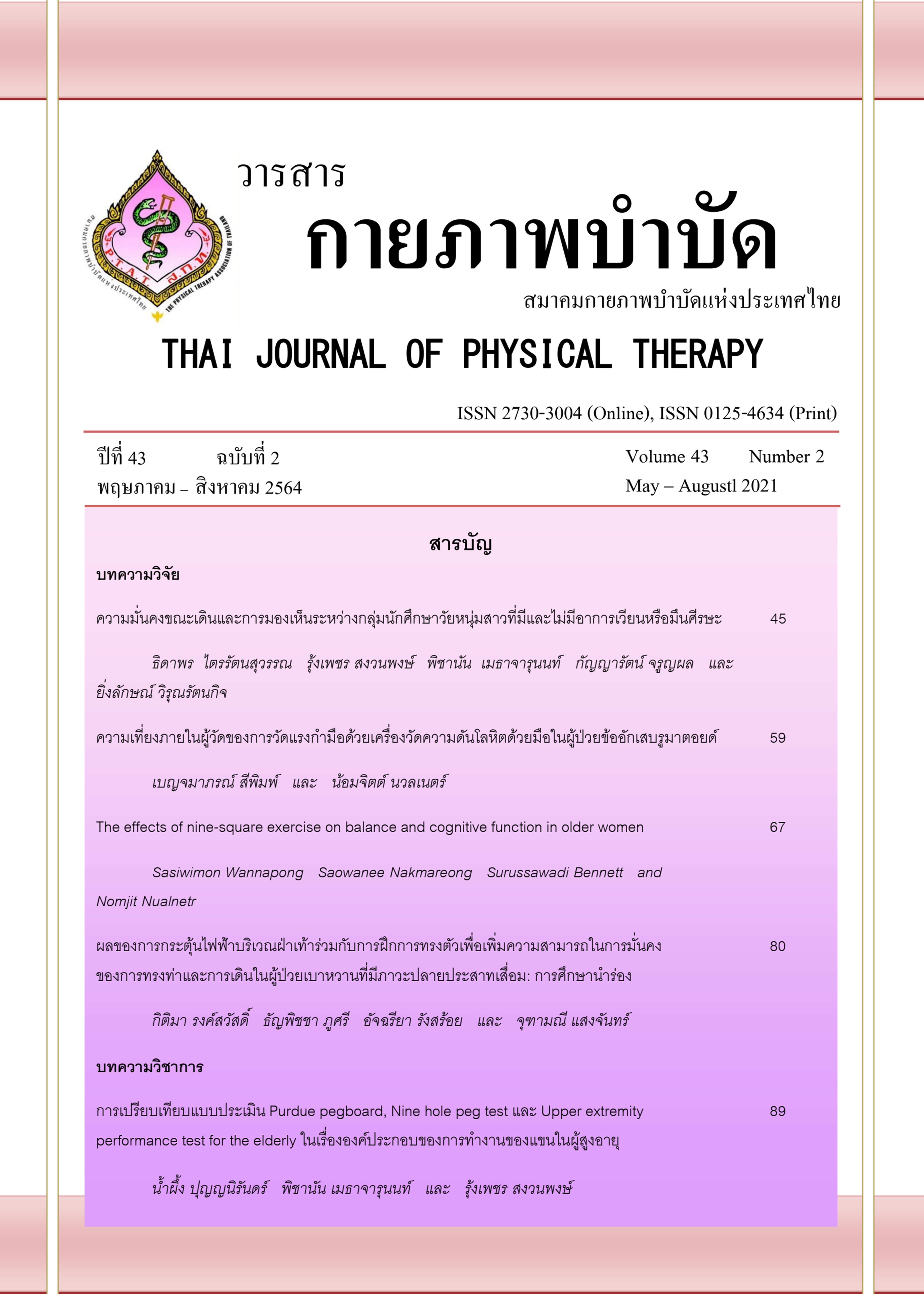ความมั่นคงขณะเดินและการมองเห็นระหว่างกลุ่มนักศึกษาวัยหนุ่มสาวที่มีและไม่มีอาการเวียนหรือมึนศีรษะ
Main Article Content
บทคัดย่อ
ที่มาและความสำคัญ: อาการเวียนศีรษะในวัยหนุ่มสาวส่งผลกระทบและเป็นอุปสรรคต่อการใช้ชีวิตประจำวัน การเดินทาง การเข้าร่วมกิจกรรมและสมาธิของการทำงาน อย่างไรก็ตาม การศึกษาอาการเวียนศีรษะซึ่งส่งผลต่อความมั่นคงของการทรงตัวและความมั่นคงของการมองเห็นยังมีอย่างจำกัดโดยเฉพาะอย่างยิ่งในวัยหนุ่มสาว จึงเป็นที่มาของการศึกษาในครั้งนี้
วัตถุประสงค์: วัตถุประสงค์หลักเพื่อศึกษาความมั่นคงของการทรงตัวและการมองเห็น โดยเปรียบเทียบระหว่างกลุ่มที่มีและไม่มีอาการเวียนศีรษะ โดยมีวัตถุประสงค์รองเพื่อศึกษาความผิดปกติของ ระบบเวสติบูลาร์ในกลุ่มวัยหนุ่มสาวที่มีและไม่มีอาการเวียนศีรษะ
วิธีการวิจัย: กลุ่มอาสาสมัครอายุระหว่าง 18 – 29 ปี จำนวน 22 คน เป็นกลุ่มที่มีอาการและไม่มีอาการเวียนศีรษะจำนวนเท่ากัน อาสาสมัครทั้งสองกลุ่มจะได้รับการซักประวัติและตรวจร่างกายพื้นฐานที่เกี่ยวข้องกับการทรงตัว การมองเห็น และการทำงานของระบบประสาทที่เกี่ยวข้องกับการกรอกตา (oculomotor test) เป็นต้น อาสาสมัครจะได้รับการตรวจประเมินความมั่นคงของการทรงตัวด้วย functional gait assessment (FGA) และความมั่นคงของการมองเห็นด้วย dynamic visual acuity (non-instrument DVA) การประเมินความผิดปกติของระบบเวสติบูลาร์จะทำการตรวจด้วยการทดสอบ head impulse test (HIT) เพื่อเปรียบเทียบระหว่างกลุ่มที่มีอาการเวียนและไม่เวียนศีรษะ การวิเคราะห์ข้อมูลทางสถิติตัวแปรหลักด้านความมั่นคงของการทรงตัวเปรียบเทียบระหว่างกลุ่มด้วย independent t-test และเปรียบเทียบสัดส่วนตัวแปรหลักด้านความมั่นคงของการมองเห็นและความผิดปกติทางด้านระบบเวสติบูลาร์ระหว่างกลุ่มซึ่งเป็นตัวแปรรองโดยใช้สถิติ Fisher's exact
ผลการวิจัย: พบความแตกต่างอย่างมีนัยสำคัญทางสถิติของความมั่นคงในการทรงตัวระหว่างกลุ่ม (p = 0.006) และพบความแตกต่างของสัดส่วนความผิดปกติของระบบเวสติบูลาร์ระหว่างกลุ่มอย่างมีนัยสำคัญทางสถิติ (p = 0.024) โดยไม่พบความแตกต่างอย่างมีนัยสำคัญทางสถิติของความมั่นคงของการมองเห็นระหว่างกลุ่ม โดยอาการเวียนศีรษะเป็นปัจจัยที่มีความสัมพันธ์ต่อความผิดปกติของการทรงตัวด้วยค่า odd ratio เท่ากับ 17.5 และ 95%CI เท่ากับ 2.02 -151.63
สรุปผล: วัยหนุ่มสาวที่มีอาการเวียนศีรษะจะมีความสามารถด้านการทรงตัวที่น้อยกว่ากลุ่มที่ไม่มีอาการเวียนศีรษะ ซึ่งอาจเป็นผลของการทำงานที่ผิดปกติของระบบเวสติบูลาร์ โดยพบว่าอาการเวียนศีรษะเป็นปัจจัยเสี่ยงที่ทำให้เกิดความผิดปกติของการทรงตัว ดังนั้นวัยหนุ่มสาวที่มีอาการเวียนศีรษะควรได้รับการตรวจประเมินด้านการทรงตัวและการทำงานของระบบเวสติบูลาร์เพื่อเป็นแนวทางสำหรับวางแผนด้านการฟื้นฟูทางระบบเวสติบูลาร์ต่อไป
Article Details
เอกสารอ้างอิง
Moulin T, Sablot D, Vidry E, Belahsen F, Berger E, Lemounaud P, et al. Impact of emergency room neurologists on patient management and outcome. Eur Neurol. 2003;50(4):207-14.
Neuhauser HK, Radtke A, von Brevern M, Lezius F, Feldmann M, Lempert T. Burden of dizziness and vertigo in the community. Arch Intern Med. 2008;168(19):2118-24.
Lin HW, Bhattacharyya N. Balance disorders in the elderly: epidemiology and functional impact. Laryngoscope. 2012;122(8):1858-61.
Gopinath B, McMahon CM, Rochtchina E, Mitchell P. Dizziness and vertigo in an older population: the Blue Mountains prospective cross-sectional study. Clin Otolaryngol. 2009;34(6):552-6.
Wiltink J, Tschan R, Michal M, Subic-Wrana C, Eckhardt-Henn A, Dieterich M, et al. Dizziness: anxiety, health care utilization and health behavior--results from a representative German community survey. J Psychosom Res. 2009;66(5):417-24.
Murdin L, Seemungal BM, Bronstein AM. Dizziness. Medicine. 2012;40(8):431-4.
Tian JR, Shubayev I, Baloh RW, Demer JL. Impairments in the initial horizontal vestibulo-ocular reflex of older humans. Exp Brain Res. 2001;137(3-4):309-22.
Hansson EE, Mansson NO, Hakansson A. Balance performance and self-perceived handicap among dizzy patients in primary health care. Scand J Prim Health Care. 2005;23(4):215-20.
Sixt E, Landahl S. Postural disturbances in a 75-year-old population: I. Prevalence and functional consequences. Age Ageing. 1987; 16(6):393-8.
Barin K, Dodson EE. Dizziness in the elderly. Otolaryngologic clinics of North America. 2011;44(2):437-54, x.
Ten Voorde M, van der Zaag-Loonen HJ, van Leeuwen RB. Dizziness impairs health-related quality of life. Qual Life Res. 2012;21(6):961-6.
Wilhelmsen K, Ljunggren AE, Goplen F, Eide GE, Nordahl SH. Long-term symptoms in dizzy patients examined in a university clinic. BMC Ear Nose Throat Disord. 2009;9:2.
Wrisley DM, Marchetti GF, Kuharsky DK, Whitney SL. Reliability, internal consistency, and validity of data obtained with the functional gait assessment. Phys Ther. 2004;84(10):906-18.
Petersen JA, Straumann D, Weber KP. Clinical diagnosis of bilateral vestibular loss: three simple bedside tests. Ther Adv Neurol Disord. 2013;6(1):41-5.
Fife TD, Tusa RJ, Furman JM, Zee DS, Frohman E, Baloh RW, et al. Assessment: vestibular testing techniques in adults and children: report of the Therapeutics and Technology Assessment Subcommittee of the American Academy of Neurology. Neurology. 2000;55(10):1431-41.
Demer JL, Honrubia V, Baloh RW. Dynamic visual acuity: a test for oscillopsia and vestibulo-ocular reflex function. Am J Otol. 1994;15(3):340-7.
Herdman SJ, Tusa RJ, Blatt P, Suzuki A, Venuto PJ, Roberts D. Computerized dynamic visual acuity test in the assessment of vestibular deficits. Am J Otol. 1998;19(6):790-6.
El-Kashlan HK, Shepard NT, Asher AM, Smith-Wheelock M, Telian SA. Evaluation of clinical measures of equilibrium. Laryngoscope. 1998;108(3):311-9.
Alsalaheen BA, Whitney SL, Marchetti GF, Furman JM, Kontos AP, Collins MW, et al. Performance of high school adolescents on functional gait and balance measures. Pediatr Phys Ther. 2014;26(2):191-9.
Longridge NS, Mallinson AI. Clinical romberg testing does not detect vestibular disease. Otology & neurotology : official publication of the American Otological Society, American Neurotology Society [and] European Academy of Otology and Neurotology. 2010;31(5):803-6.
Hall CD, Herdman SJ, Whitney SL, Cass SP, Clendaniel RA, Fife TD, et al. Vestibular Rehabilitation for Peripheral Vestibular Hypofunction: An Evidence-Based Clinical Practice Guideline: FROM THE AMERICAN PHYSICAL THERAPY ASSOCIATION NEUROLOGY SECTION. Journal of neurologic physical therapy : JNPT. 2016;40(2):124-55.
Saman Y, Bamiou DE, Murdin L, Tsioulos K, Davies R, Dutia MB, et al. Balance, falls risk, and related disability in untreated vestibular
schwannoma patients. Journal of neurological surgery Part B, Skull base. 2014;75(5):332-8.
Baker BJ, Curtis A, Trueblood P, Vangsnes E. Vestibular functioning and migraine: pilot study comparing those with and without vertigo. The Journal of laryngology and otology. 2013;127(11):1056-64.
Staab JP. Chronic dizziness: the interface between psychiatry and neuro-otology. Current opinion in neurology. 2006;19(1):41-8.
Burgio DL, Blakley BW, Myers SF. The high-frequency oscillopsia test. Journal of vestibular research : equilibrium & orientation. 1992;2(3):221-6.
Shippman S, Heiser L, Cohen KR, Hall LS. Dynamic visual acuity: its place in ophthalmology? The American orthoptic journal. 2005;55:139-43.


